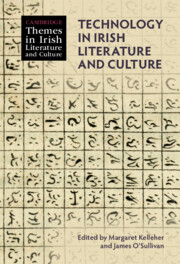Book contents
- Technology in Irish Literature and Culture
- Cambridge Themes in Irish Literature and Culture
- Technology in Irish Literature and Culture
- Copyright page
- Epigraph
- Contents
- Contributors
- Cambridge Themes in Irish Literature and Culture
- Acknowledgements
- Introduction
- Part I Genealogies
- Chapter 1 Print as Technology: The Case of the Irish Language, 1571–1850
- Chapter 2 Printing and Publishing Technologies, 1700–1820
- Chapter 3 The Optical Telegraph, the United Irish Press, and Maria Edgeworth’s ‘White Pigeon’
- Chapter 4 Technologies of Sound: Telephone/Gramophone
- Part II Infrastructures
- Part III Invention
- Part IV The Digital
- Index
- References
Chapter 4 - Technologies of Sound: Telephone/Gramophone
from Part I - Genealogies
Published online by Cambridge University Press: 19 January 2023
- Technology in Irish Literature and Culture
- Cambridge Themes in Irish Literature and Culture
- Technology in Irish Literature and Culture
- Copyright page
- Epigraph
- Contents
- Contributors
- Cambridge Themes in Irish Literature and Culture
- Acknowledgements
- Introduction
- Part I Genealogies
- Chapter 1 Print as Technology: The Case of the Irish Language, 1571–1850
- Chapter 2 Printing and Publishing Technologies, 1700–1820
- Chapter 3 The Optical Telegraph, the United Irish Press, and Maria Edgeworth’s ‘White Pigeon’
- Chapter 4 Technologies of Sound: Telephone/Gramophone
- Part II Infrastructures
- Part III Invention
- Part IV The Digital
- Index
- References
Summary
The Irish Literary Revival at the turn of the twentieth century was heavily invested in the value of orature, characteristically associated with peasant culture as the living remnant of pre-modern society, which is typically seen as being on the verge of its final disappearance. Focusing on Augusta Gregory and W. B. Yeats, this essay resituates the relationship between orature and modernity in Irish culture in the context of technology, noting that the Revival coincides exactly with the period – from the late 1880s to the early 1920s – that saw the emergence of key technologies of sound: the telephone, the gramophone/phonograph, and later radio. A key concept here is the idea of over-lapping histories of technology; running alongside histories of technological innovation, political economy, and social change is a hidden history of technologies of sound as the ghost of oral culture, imbricated in some of the same literary narratives that memorialise the pre-modern.
Keywords
- Type
- Chapter
- Information
- Technology in Irish Literature and Culture , pp. 65 - 80Publisher: Cambridge University PressPrint publication year: 2023

